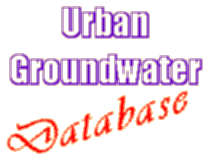 |
 |
 |
 |
Perth has a population of about 1 million and is a commercial centre with a very small industrial base. It is one of the most rapidly developing cities in Australia, and the population is expected to double by 2020. About 60% of the city is sewered and the remainder is being progressively connected to sewer. The population density is low and the city covers an area of more than 700 km2.
Mediterranean climate (winter rain, summer drought). The average annual rainfall is about 800 mm and the potential evaporation is 2500 mm. On average, evaporation exceeds rainfall for 8 months of the year.
Perth is located in a sedimentary basin and is underlain by porous medium aquifers. A sandy surficial aquifer underlies much of the city and this in turn is underlain by confined sandstone aquifers. The surficial aquifer is recharged by rainfall and deeper aquifers by leakage. On average, the recharge rate in undeveloped areas is about 15-25 % of annual rainfall and up to 35% of rainfall in urban areas. Groundwater discharges to the ocean, wetlands and the Swan estuary.
Groundwater provides about 40% of Perth's potable supply and 70% of the city's total water usage. Groundwater is widely tapped for the irrigation of gardens and parks and there are about 100 000 irrigation bores in the Perth metropolitan area.
The maintenance of high quality potable groundwater in close proximity to Perth is probably the most pressing issue currently facing regulators. Other issues include minimising the contamination of groundwater by nitrate to prevent the eutrophication of waterways in groundwater discharge zones, and minimising the drawdown of the watertable in abstraction areas to protect native phreatophytic vegetation.
Contamination of water supply bores in urban areas; local saltwater intrusion problems in coastal areas; discharge of nutrients by groundwater to wetlands and coastal environments. The most severe groundwater contamination problems occur in the Kwinana industrial area to the south of Perth. Many light industrial areas occur near housing estates, and further work is required to determine the potential impact of a wide range of inorganic and organic contaminants on nearby residents who use groundwater for garden irrigation.
Use of groundwater protection zones in undeveloped areas to protect potable supplies. Carry out hydrogeological investigations and vulnerability mapping to identify areas that are highly susceptible to contamination. Undertake appropriate zoning of land use to protect groundwater in vulnerable areas.
Appleyard, S., 1995, Impact of urban development on recharge and groundwater quality in a coastal aquifer near Perth, Western Australia, Hydrogeology Journal, v3, p 65-75. Barber, C., R. Barron, J. Broun, L. Bates, K. Taylor and K. Locksey, 1994,] Evaluation of the relationship between land use changes and groundwater] quality in a water supply catchment using GIS technology: The Gwelup] wellfield, Western Australia: Proceedings of the IAH Water Down Under '94] Conference, Adelaide, Australia, 21-25 Nov. 1994, p. 247-251. The Select Committee on Metropolitan Development and Groundwater Supplies, 1994, Report to the Western Australia Legislative Assembly. State Low Publisher, 815 Hay Street, Perth, WA 6000, fax 09 321 8422Back to Topics
Water and Rivers Commission, Hyatt Centre, 3 Plain Str, East Perth, WA 6004,
Western Australia, tel. 09 278 0300, fax 09 278 0301
CSIRO Division of Water Resources, Private Bag, PO Wembley, WA 6014, tel 09
387 0200, fax 09 387 8211